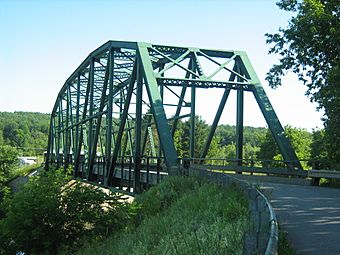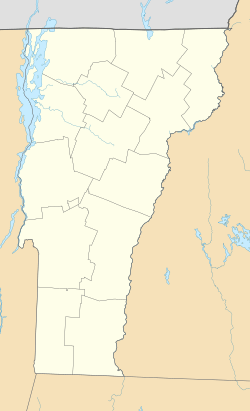Bridge 12 facts for kids
Quick facts for kids |
|
|
Bridge 12
|
|
 |
|
| Location | Boston Post Rd., Enosburg, Vermont |
|---|---|
| Area | less than one acre |
| Built | 1929 |
| Architectural style | Parker through truss |
| MPS | Metal Truss, Masonry, and Concrete Bridges in Vermont MPS |
| NRHP reference No. | 07001299 |
| Added to NRHP | December 20, 2007 |
Bridge 12 is a special old bridge in Enosburg, Vermont. It carries Boston Post Road over the Missisquoi River. This bridge is a type called a Parker through truss bridge. This means its strong metal framework, or "truss," goes above the road, and cars drive "through" it.
The bridge was built in 1929. This was right after a very big flood in Vermont in 1927 that destroyed many bridges. Bridge 12 is important because it's one of the few truss bridges left on the Missisquoi River from that time. In 2007, it was added to the National Register of Historic Places. This list includes important buildings and places in the United States that should be protected.
Contents
What is Bridge 12 Like?
Bridge 12 is in a quiet, countryside part of northern Enosburg. It helps Boston Post Road cross the Missisquoi River. This spot is just south of Vermont Route 105, which is a main road that goes east and west.
How Big is the Bridge?
The bridge is about 204 feet (62 meters) long. It sits on strong concrete supports called abutments at each end. The whole bridge is about 18 feet 9 inches (5.7 meters) wide. The part where cars drive, the roadway, is about 16 feet 6 inches (5 meters) wide.
The metal framework, or truss, has eight triangle-shaped sections. The middle sections have extra supports to make them even stronger. These trusses are connected at the top by metal bars called sway bracing. This bracing helps the bridge stay steady. The road itself is made of concrete, supported by steel beams underneath.
Why Was Bridge 12 Built?
Bridge 12 was built in 1929. It was designed by L.H. Shoemaker, and the metal parts were made by a company in Buffalo, New York. Before this bridge, there were probably other wooden bridges at this same spot, going back to the 1870s.
The Great Vermont Flood of 1927
A huge flood hit Vermont in 1927. It was a very serious event that washed away more than 1,200 bridges across the state! After this flood, Vermont started building bridges in a more standard way. This helped make sure new bridges would be stronger and safer. Bridge 12 is a great example of these new, stronger bridges built after the flood. It's also special because not many truss bridges like it are still standing on the Missisquoi River today.



